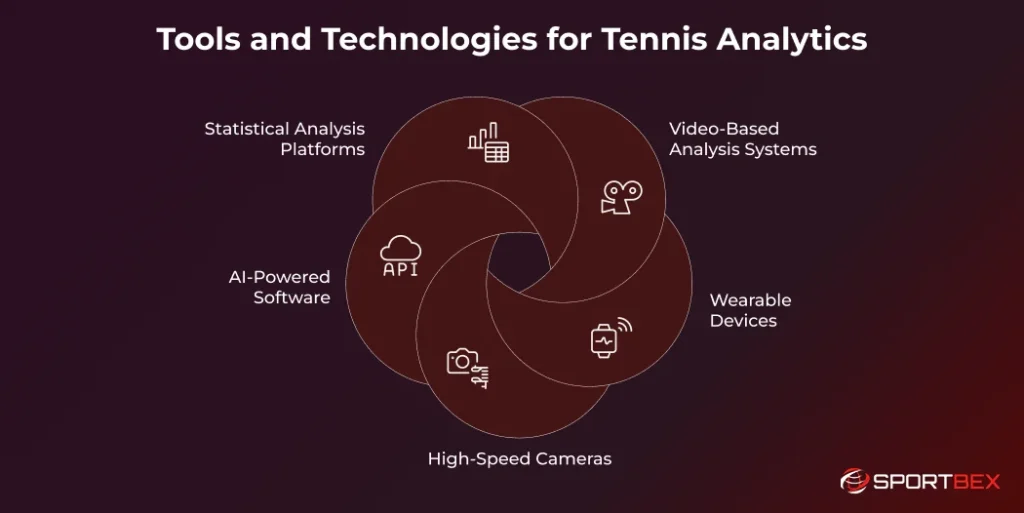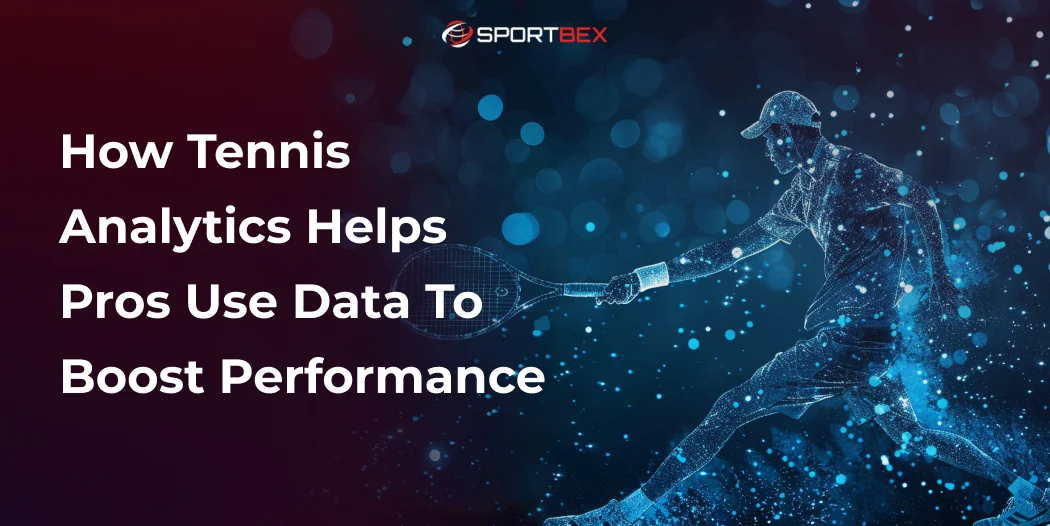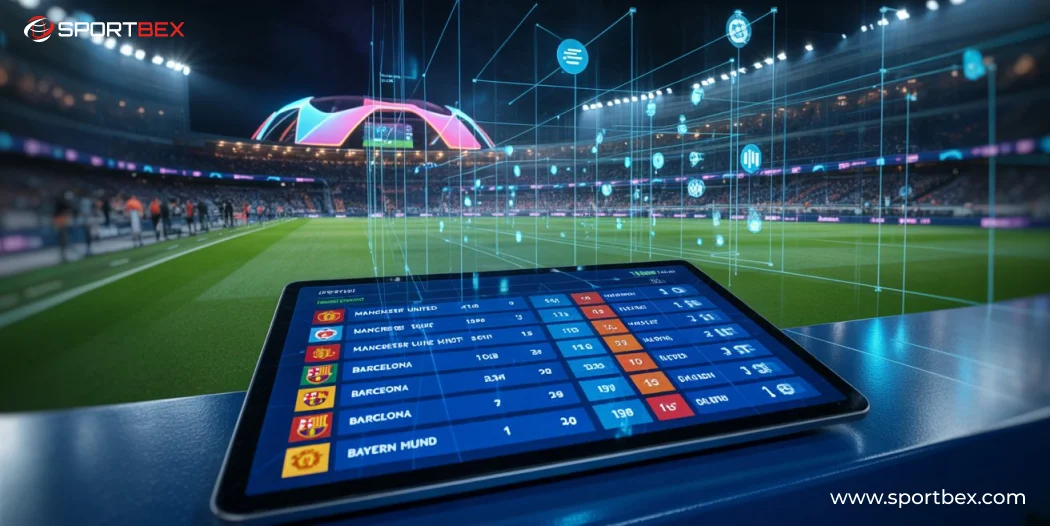In tennis, winning is no longer just about talent or practice. The game now relies heavily on tennis analytics to decide who wins and who loses. Data-driven insights are changing how players train, strategize, and play. By analyzing tennis performance data such as serve speed and movement efficiency, players can make smarter decisions, improve training, and gain an edge over opponents.
Whether you’re a coach, a junior player, or just a fan of tennis, learning about tennis data analytics can teach you how champions succeed. By looking at tennis data from big tournaments, integrating statistics through a Tennis API, and using match analytics to review games, you can spot what works and what doesn’t. Understanding this data can help turn a tough loss into a smart win.
This guide will explain the basics of tennis analytics, How Tennis Analytics Uses Data to Boost Player Performance, the tools and technologies behind it, how the tennis statistics API helps track performance in real-time, and what the future of data-driven tennis looks like.
What is Tennis Analytics?
Tennis analytics involves using data to help players enhance their performance on the court. This data can be collected from various sources, including match statistics, training sessions, or even past games.
By analyzing this information, players and coaches can identify patterns, strengths, and areas for improvement. The goal isn’t just to gather numbers but to transform them into actionable strategies, such as refining techniques, adjusting game plans, or preparing for specific opponents.
Tennis analytics connects traditional coaching with modern technology. For example, smart wearables and video systems can show if a player’s forehand works better cross-court or down the line, or if their second serve struggles under pressure. Coaches can use this data to help players improve their game.
Why Tennis Professionals Use Data
At the professional level, the difference between winning and losing often comes down to the smallest details. Data helps players to:
- Identify patterns in their own game and their opponents’ games.
- Quantify strengths and weaknesses with objective evidence.
- Measure improvement over time.
- Fine-tune strategies based on real match conditions.
For example, a player might notice their first serves are less accurate in the final set, perhaps due to fatigue or pressure, which can shift the momentum of the match. Similarly, they might observe that their opponent struggles with backhands when stretched wide, especially under fast-paced rallies or when forced to move quickly across the court.
Key Data Points Used in Tennis Analytics

Serve Speed & Accuracy
Tracking serve speed provides an indication of a player’s power, demonstrating their ability to generate force and velocity in their shots. On the other hand, accuracy reveals how well they can target specific zones on the court, highlighting their precision and tactical awareness.
A powerful, well-placed serve can be a game-changer, forcing opponents out of their comfort zone and limiting their options for return shots. Consistently serving with both speed and precision puts immediate pressure on opponents, reducing their ability to control rallies and often leading to unforced errors or weaker returns, giving the server a clear advantage in the game.
Shot Placement
Shot placement data reveals where players hit the ball on the court—whether it’s near the baseline, into the corners, or at short angles closer to the net. By analyzing these patterns, we can gain insight into a player’s style of play.
For instance, frequent shots to the corners might indicate an aggressive strategy aimed at keeping opponents on the move, while consistent baseline play could suggest a more defensive approach focused on endurance and precision.
By using a tennis data API, coaches and analysts can access detailed tennis performance data to identify which areas of the court a player performs best in, offering valuable information for strategy and improvement.
Movement Patterns
Movement analysis evaluates how effectively players move on the court, emphasizing key aspects like recovery steps, split-step timing, and the balance between side-to-side and forward movement. By identifying areas of inefficiency or imbalance, players can work on refining their footwork and positioning.
Improving these movements not only helps conserve energy during long matches but also enhances their ability to defend and transition smoothly between offensive and defensive plays. This analysis is critical for players looking to elevate their overall performance and maintain consistent form throughout a game.
Tactical Decision-Making
This focuses on whether players are making the right shot choices in specific situations during a match. For example, when facing a critical break point, should they take an aggressive approach and move towards the net to put pressure on their opponent, or would it be smarter to stay at the baseline and play a more defensive shot?
These decisions can significantly influence the outcome of a match. By analyzing data, players and coaches can better understand which strategies and shot selections consistently lead to more favorable results, allowing them to refine their game and make smarter choices under pressure.
Unforced Errors
Reducing mistakes is crucial for staying in control and performing well during matches. Mistakes can often shift the momentum of a game, making it harder to recover. By keeping track of when and where these errors occur, players can identify patterns and pinpoint areas that need improvement.
Whether it’s a missed shot, a timing error, or a lapse in focus, understanding the root cause of these mistakes helps players develop strategies to avoid them in the future. This focused approach not only builds confidence but also enhances overall performance over time.
Tools and Technologies for Tennis Analytics

Video-Based Analysis Systems
High-resolution video plays a crucial role in helping coaches analyze matches in greater detail, allowing them to review every moment frame by frame. This level of precision is invaluable for identifying strengths, weaknesses, and opportunities for improvement.
Additionally, advanced tools like Hawk-Eye provide accurate line calls, track player movements, and even generate heatmaps to visualize positioning and patterns. These technologies give coaches and players deeper insights, enabling more effective strategy planning and performance optimization.
Wearable Devices
Smart wearables are revolutionizing sports by providing detailed insights into a tennis players performance. These devices can track how players move, monitor their heart rate, and even analyze the type of stroke or technique they use. With advanced sensors and technology, wearables deliver real-time updates on performance during both practice sessions and games.
This data can help athletes fine-tune their techniques, improve endurance, and reduce the risk of injuries by identifying areas of strain or incorrect movements. Coaches and trainers can also use this information to create personalized training plans, making smart wearables an essential tool for modern sports.
High-Speed Cameras
High-speed cameras have become a game-changer in tennis analytics by capturing every moment of play at an exceptionally high frame rate. Unlike standard video, these cameras can record hundreds or even thousands of frames per second, allowing analysts to slow down the footage and examine every tiny movement in a player’s technique.
This ultra-detailed view helps coaches and players identify subtle flaws in strokes, serves, and footwork that are often missed in real-time. High-speed cameras are particularly valuable for studying the biomechanics of a swing, the spin and trajectory of the ball, and the precision of shot placement.
AI-Powered Software
Artificial intelligence rapidly analyzes extensive match footage and performance statistics using advanced tennis analytics software, processing vast amounts of past data to identify patterns and trends that may otherwise go unnoticed. By examining player movements, team formations, and game outcomes, AI uncovers valuable insights that can significantly impact decision-making.
It combines historical data with advanced predictive algorithms to forecast potential scenarios and outcomes, providing coaches, players, and analysts with highly actionable recommendations. These insights help refine strategies, improve individual and team performance, and gain a competitive edge in an increasingly data-driven sports world.
Statistical Analysis Platforms
Advanced platforms combine match stats, player habits, and past performance to create detailed and insightful reports that help players and coaches make informed decisions.
These platforms often utilize Tennis API technology to provide live match updates, enabling quick analysis and real-time adjustments during gameplay.
By integrating this tennis performance data, professional tennis data, and insights from the tennis statistics API, users gain a deeper understanding of tennis players’ strengths, weaknesses, and strategies, all in one convenient tool, while leveraging the tennis live API for up-to-the-minute tracking.
How Data Improves Player Performance
The use of tennis analytics leads to measurable improvements in player performance. Data-driven insights help players identify weaknesses and maximize strengths through strategic adjustments. One key benefit is technical improvement. Video analysis and biomechanical data highlight inefficiencies that players and coaches can address with targeted practice. For example, a player might find their backhand cross-court shots lack depth, prompting drills to improve shot penetration and positioning.
Strategic development thrives on detailed opponent analysis and situational stats. Players can create better game plans by identifying opponent weaknesses, like struggling with high-bouncing shots to their backhand, and tailoring tactics to exploit them.
Mental preparation improves when players understand their own tennis performance metrics and opponent tendencies. For example, knowing they excel in tiebreakers or struggle with break point conversions allows them to create better mental strategies during tennis tournaments.
Physical conditioning becomes more effective when informed by movement data and physiological monitoring. Players covering too much court may need better positioning, while those showing cardiovascular stress might benefit from improved fitness training.
The Future of Tennis Analytics
In the future, the Use of a tennis API and AI-driven insights will become standard in both professional and amateur coaching. Real-time tennis players tracking will enable on-court coaching decisions within seconds. Augmented reality training could simulate opponent patterns based on past match history, while machine learning models will predict injury risks before they happen.
Making data accessible means that tools once used only by top athletes will soon be available to junior players, academies, and even hobbyists. This will create a new generation of athletes who can use data just as well as they play the game.
Get a Ready-Made Platform On Rent.
Get Started Today
Conclusion
Tennis analytics is changing the game. Improving performance is no longer just about instinct or practice—now, science plays a big role. With professional tennis data, players can analyze every part of their game, from training sessions to big matches, to get better and play smarter.
As technology improves, tools like the tennis statistics API and even a sports betting API are changing the way tennis is played, coached, and enjoyed. Using tennis data analysis gives players and coaches a clear advantage by combining skill with smart strategies. The champions of the future won’t just have powerful serves or accurate shots—they’ll also understand the numbers that drive the game.
Tennis is all about precision, and now technology is helping measure and improve it like never before. In today’s game, the player who understands the tennis sports data best could have the biggest advantage on the court.
Frequently Asked Questions
Tennis analytics is the process of collecting, analyzing, and interpreting tennis performance data to improve player outcomes. Professionals use it to evaluate serve speed, shot placement, movement efficiency, and tactical decisions. These insights help coaches and players make strategic adjustments during training and matches.
Tennis match analytics collects a wide range of information, including serve statistics, rally lengths, shot placement maps, unforced errors, winners, and player movement patterns. This data is often captured using high-speed cameras, sensors, and advanced tracking systems.
A tennis statistics API allows developers, coaches, and analysts to access real-time and historical tennis data from matches worldwide. This can be integrated into performance dashboards, apps, and analysis tools, making it easier to track and visualize player performance trends.
Absolutely. While top-ranked pros use highly advanced systems, amateur players can still benefit from professional tennis data by identifying strengths and weaknesses in their game. Affordable wearables, video analysis apps, and tennis data APIs have made performance tracking more accessible than ever.
The future will likely see increased use of AI, machine learning, and predictive analytics. Soon, tennis live API integration could enable real-time strategic adjustments during matches, while augmented reality could be used in training to simulate opponent behavior based on historical data.
Recent Blog
Top 9 Bowlers With Most Wickets In Test Cricket
October 22, 2025
 7 min
7 min
How to Create a Soccer Leaderboard Using API Data
October 22, 2025
 9 min
9 min






